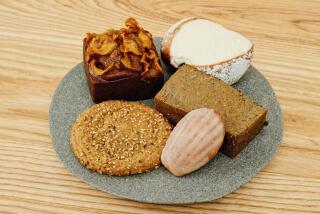Commentary: How could you do this, ‘Great British Baking Show’?
- Share via
There’s a lot going on in the world right now, but we shouldn’t allow the nonstop horror of the news to distract us from the smaller injustices happening all around us.
Like, for instance, this week’s “The Great British Baking Show.”
The beloved reality competition series has weathered its share of controversies — or at least what passes for “controversy” on a show where kindess is a virtue and the prize is an engraved platter.
There was the time viewers complained about all the naughty puns. Or the time a sloppy edit made it look like one contestant had sabotaged someone’s Baked Alaska — which of course she hadn’t, because this isn’t “Survivor,” or even “Top Chef.”
But nothing compares to the scandal of this week’s episode, which ended in a rare (and needless) double elimination. Judges Prue Leith and Paul Hollywood sent home the industrious Michelle Evans-Fecci, whose bakes often celebrated her Welsh heritage, and Helena Garcia, a Spanish expat from Leeds known for playfully ghoulish creations (e.g., cookies made to look like witch fingers, or a chocolate orange tarantula emerging from a shortbread egg).
Michelle seemed to expect the verdict, but Helena — or, as I like to call her, Goth Penelope Cruz — figured she was safe. And if the world were a just and fair place, she would have been.
Even on a show where decisions are by definition a matter of taste, Helena’s ouster was baffling.
For her signature bake, she made lemon and lavender custard pies that looked like a squirming octopus. (The decoration was “incredible,” gushed Paul.) She won the technical challenge by being one of the only bakers to whip up passable beignets. Her showstopper, a pink and green “vampire’s kiss”-themed layer cake, was a mixed bag: a little messy-looking, but tasty enough.
Yet Prue and Paul decided to send her packing while giving a pass to two vulnerable contestants: Priya O’Shea, a marketing consultant with chronic time management issues who’s consistently at the bottom of the pack, and rabbit-hating veterinarian Rosie Brandreth-Poynter, who dropped one of her custard pies and served another with melted decorations.
The decision has prompted anger and charges of anti-Goth bias on social media, including a hashtag, #JusticeForHelena. Why would Paul and Prue give the boot to the show’s most endearingly eccentric baker, especially after she’d just won a technical challenge? Do they have something against the occult? Is her kooky, Pinterest-ready style of baking simply not their thing?
Maybe — Paul Hollywood rolled his piercing blue White Walker eyes more than once over Helena’s creations — but she is hardly the first contestant to lean into the whimsy (see: last year’s cat-loving finalist Kim-Joy Hewlett). And few have done it with as much charm or sass as Helena.
On social media, she makes cute topical jokes about “witch hunts” and cheekily refers to Paul as “Pablo.” In the tent, she bonded with presenter Noel Fielding over their shared love of all things dark and haunted.
She may “live every day like it’s Halloween,” as she claimed in the season premiere, but she’s also hilarious, sweet and self-deprecating. Case in point: When Prue reached out to get a fly out of her hair, Helena, 40, responded cheerfully in her thickly accented English, “They come to me ’cause I’m dead.” How could anyone other than the Prince of Darkness himself not love this woman?
Even on a show with (some) integrity like “The Great British Baking Show,” personality matters, and Helena is — or was — easily the most winning contestant of the current batch.
Helena’s dismissal was egregious because it summed up what has changed about the show since it left the BBC for the U.K.’s Channel 4 three years ago, a move that prompted the departure of original presenters Mel Giedroyc and Sue Perkins and judge Mary Berry — and has, I’m afraid to say, resulted in a subtle yet noticeable shift in tone. (In the U.S., it moved from PBS to Netflix, where new episodes stream weekly a few days after they air in the U.K.)
Part of what has made “The Great British Baking Show” so special is that it lacked the kind of obvious manipulations and producer-staged drama common on American competition shows, but it has taken a gimmicky turn of late. In last season’s finale, the bakers had to make pita bread over an open fire, a test of their survival skills rather than their baking proficiency.
The episodic themes have grown increasingly obscure as well: This week celebrated “The Roaring Twenties,” a decade known for drinking rather than desserts. (On the bright side, at least it wasn’t 1930s week.)
Similarly, there was no real logistical reason for this week’s double elimination, except contrived drama; it seemed like something conjured by producers looking to stir up social-media outrage. (And, well, it worked).
Worse, an egalitarian show that has showcased bakers from an array of religious, ethnic and class backgrounds seems to have gotten snobbier and more exclusive. Helena left a week after Phil Thorne, a 56-year-old truck driver from working-class Essex, was sent packing. His crime? Making gnome-shaped Indian milk sweets inspired by his back garden. (Truly the cat with nine lives, Priya presented uncooked blobs of pastry and lemon curd for the technical and somehow didn’t get cut.)
Helena is Spanish but grew up in the Canary Islands and spent formative time in the U.S. — Las Vegas, to be exact. Her aesthetic is not what you’d call refined. It’s also much more American than is typical for “The Great British Baking Show,” which typically celebrates regional delicacies like Bakewell tarts and Victoria sponge. One of Helena’s few non-spooky bakes was a batch of gooey cinnamon rolls that would have made Paula Deen proud. That, in the end, may have sealed the fate for Helena, the quirky Goth queen.
She may be gone, but to her fans, Helena will never be dead.
More to Read
The complete guide to home viewing
Get Screen Gab for everything about the TV shows and streaming movies everyone’s talking about.
You may occasionally receive promotional content from the Los Angeles Times.






